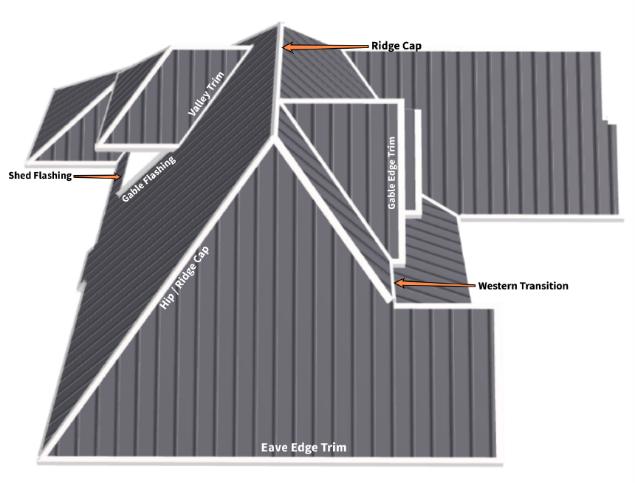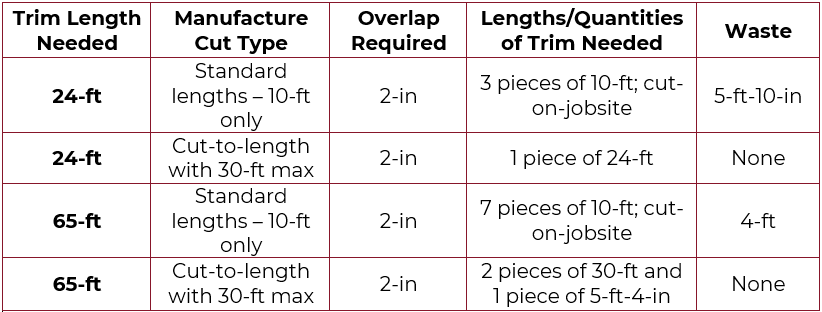Accurate Roof Takeoffs – Step 4: Calculate Accessories & Trim Needed
Replacing a residential roof requires careful planning and calculation of materials, costs, and labor requirements. The process of estimating materials and dimensions for a roof replacement is called a roof takeoff. A precise takeoff helps ensure that a contractor orders the correct amount and lengths of metal panel, trim, and accessories to manage project costs effectively.
In the previous article in this series we discussed roof panels and underlayment and today we will cover the trim and accessories needed to finish off the project.
Types of Trim
The three main material categories are roofing material, underlayment, and additional components. In the previous article, we discussed roofing material and underlayment for the roof sections. In this article, we will dig into trim parts and other components.
A. Trim and Flashing:

Metal trim and flashing is used around roof edges, valleys, chimneys, and other areas prone to water intrusion. You have already captured these measurements while measuring the lengths and widths of sections of roof. Most trims come in either standard lengths (like 10-ft, 12-ft, 16-ft, etc.) or cut-to-length options. If you decide on the standard lengths and will need an overlap to cover the entire length of the section, be sure to account for this overlap in your order, again consulting the installation guide or product guides for overlap recommendations.
Trim conditions that require angle measurements for proper bending include Ridge Cap, Hip Ridge, Valley, Transitions (Upper and Lower gambrel), Eave, High Side (roof with single slope) and Shed flashing (endwall). Other trim conditions are 90-degree bends, including gable edge and gable flashing (sidewall).
Example chart for trim lengths:

B. Trim Types and Uses
Ridge cap – trim piece that covers the peak of a roof. The top peak is known as the ridge cap and lower peaks (on other sections of roof) are known as hip ridges. Depending on the selected panel, you can usually find a matching ridge cap in standard, wide, and vented.
Valley – trim piece that covers valley area where two roof planes come together, typically at a 90-degree angle. Depending on the selected panel, you can usually find a matching valley in standard and wide.
Upper gambrel – trim piece that covers a transition where two different roof slopes – low slope angle into a higher angle.
Lower gambrel (western transition) – trim piece that covers a transition where two different roof slopes meet – high slope angle into a lower angle. Lower gambrel trim is sometimes offered in standard and wide options.
Rake – trim piece that covers the sides of the roof (known as the gable edge).
Eave or Drip – trim piece that covers the front edge of the roof over the fascia board. Eave trim has no overhang whereas a drip edge trim does have an overhang. The solution for your project will depend on the panel chosen and choice of gutter system.
High Side – trim piece for the peak of a single slope roof.
Endwall – trim piece for where a wall of the structure meets the roof on an angled plane, for example in front of a dormer or chimney. This is sometimes referred to as shed flashing and available in a few styles and sizes.
Sidewall – trim piece for where the slope of a roof runs alongside a wall of the structure, for example on the sides of a dormer or chimney. This is sometimes referred to as gable flashing and available in a few styles and sizes.
Gutters – utilized to capture water at the front edge of the roof and divert downspouts on the sides of the building and away from the structure. Gutters are available in multiple styles and sizes and based on customer desires and function needed.
Fascia – utilized to cover the wood fascia board at the front edge of the roof. May be used in combination with eave or drip edge. Fascia is not necessary for properly treated/finished wood depending on customer desires.
Types of Accessories
Fasteners and Rivets: Metal panels are held down by screws into the roof decking or purlins and trim is held on with either screws or rivets, depending on the product chosen. To ensure you calculate the correct number of fasteners needed, you will need to refer to the manufacturer’s installation guide for recommendations for count per linear foot of panel and trim types.
Ventilation: If desired, ridge caps can be ordered with ridge vents. For metal roofing, you can select foam ventilation strips or for some trim types you can select vented zee closures (a metal piece of trim with vents in it). Either way, be sure to order enough for both sides of the ridge cap (i.e. length multiplied by two).
Closures: Closures are foam pieces shaped like the panel profile you’ve selected. They help seal up the end of panels from pests and weather. Closure quantities can be determined by the number of panels that meet the trim that requires closures. For example, if you need 1 closure per panel where it meets the ridge cap and 13 panels meet the ridge cap on each side of the roof, you will need 26 closures to cover the ridge condition.
Butyl Tape: This sticky tape is used to help seal up any places normal sealant can’t go. It’s impermeable to water, so it’s perfect to keep out the elements. Butyl is ordered in rolls (example: 45-ft rolls) and should be ordered for anywhere panels meet trim that requires butyl tape. For example, if butyl is recommended on all ridge caps and you have 45-ft of ridge to cover, you would need 2 times the length to cover both sides of the ridge, equaling 2 rolls of butyl.
Sealant: Sealants are used to keep water from running back underneath a roof panel. These tubes of sealants can be used around certain trim parts and pipe flashing to ensure a weather seal is made. To ensure you have the right amount of sealant, we estimate approximately 1 tube of sealant would be needed per 4 squares of roof.
Pipe Flashing: Used to seal around ventilation pipes in your roof. There are a variety of sizes and types for your needs. The count needed would equal the number of pipes extruding from the roof. Learn more about Central States’ offering of accessories.
Panels? Check. Trim? Check. Accessories? Check. What else should I know?
Now that we’ve covered the details on panels, trim, accessories, and underlayment, we’ll investigate calculating other costs and things to consider in labor, freight, and more. Until then, if you’d like to learn more about our products and services, please review the products section or contact us to be connected with a salesperson to get started.

